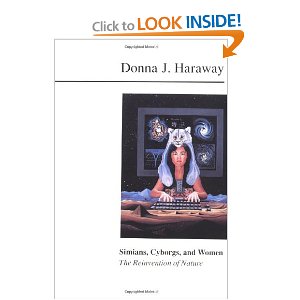Simians, Cyborgs and Women is a powerful collection of ten essays written between 1978 and 1989. Although on the surface, simians, cyborgs and women may seem an odd threesome, Haraway describes their profound link as "creatures" which have had a great destabilizing place in Western evolutionary technology and biology. Throughout this book, Haraway analyzes accounts, narratives, and stories of the creation of nature, living organisms, and cyborgs. At once a social reality and a science fiction, the cyborg--a hybrid of organism and machine--represents transgressed boundaries and intense fusions of the nature/culture split. By providing an escape from rigid dualisms, the cyborg exists in a post-gender world, and as such holds immense possibilities for modern feminists. Haraway's recent book, Primate Visions, has been called "outstanding," "original," and "brilliant," by leading scholars in the field. Simians, Cyborgs, and Women tradition--establishing
Editorial Reviews
From Publishers Weekly
Scholars of modern feminist theory, particularly of perspectives on science (notably biology) and how they relate to perceptions of human culture, will appreciate these 10 essays by science historian Haraway ( Primate Visions ), adapted from articles published between 1978 and 1989. They chart a shift in her standpoint during this period: the earliest works reflect a Marxist analytical influence (as befits "a proper, US socialist-feminist" of the '70s), while the later ones also show the influence of post-modernism. "Animal Sociology and a Natural Economy of the Body Politic" surveys primatology research of the 1930s and '40s to explore how the "principle of domination" is embedded in some scientific thought. "Gender for a Marxist Dictionary," in which Haraway develops a definition for the word "gender," highlights the difficulty of reducing complex concepts to keywords. "The Biopolitics of Postmodern Bodies" views the "biomedical, biotechnical" self, incorporating modern discourse on the immunological system; bodies, like gender, she contends, "are not born; they are made" as biomedical constructs. Illustrated.
Copyright 1991 Reed Business Information, Inc. --This text refers to an out of print or unavailable edition of this title.
Copyright 1991 Reed Business Information, Inc. --This text refers to an out of print or unavailable edition of this title.
